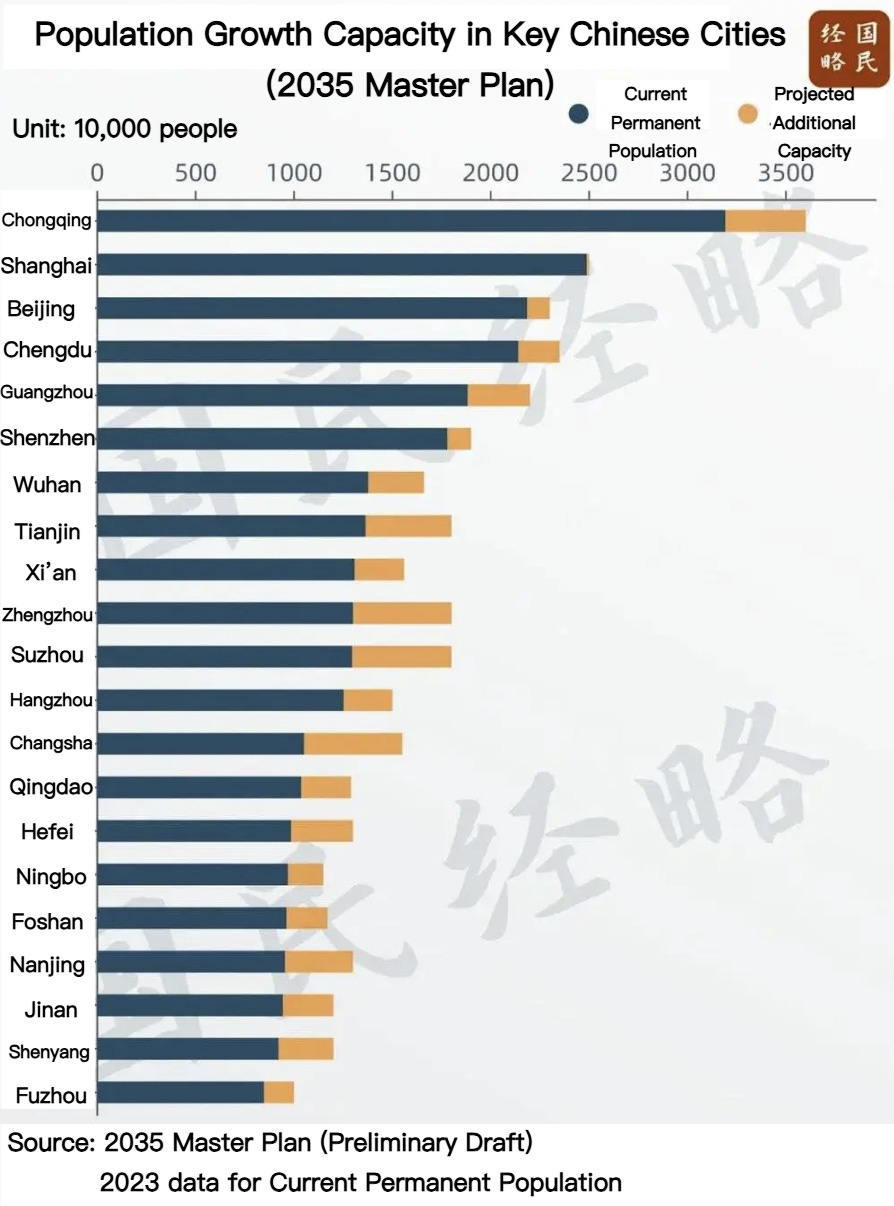How do Chinese cities beat population decline?
A look into 2035 Master Plans for 42 cities approved by the State Council
To kick off this article, I want to show you the 2023 TOP 5 ranking of China’s fastest-growing cities by population influx, based on government statistics. Hefei, Guiyang, and Zhengzhou—midwestern provincial capitals—topped the list:
Hefei, Anhui province (East China): +219,000 new residents, leading for two consecutive years, driven by its new energy vehicle (NEV) industry (e.g., BYD, NIO factories) and industrial spillover from the Yangtze River Delta.
Guiyang, Guizhou province (Southwest China): +182,500 newcomers, fueled by big data infrastructure (Huawei Cloud, Tencent data centers) and provincial policies consolidating resources under the "Strong Capital" strategy.
Zhengzhou, Henan province (Central China): +180,000 influx, leveraging electronics manufacturing (e.g., Foxconn facilities) to attract intra-provincial labor.
Hangzhou, Zhejiang province (East China): +146,000 residents, sustained by digital economy giants like Alibaba, though growth slowed compared to previous years. (Amber from our team published an article about why Hangzhou can be the city behind DeepSeek’s rise)
Chengdu Sichuan province (Southwest China): +135,000 increase, with urbanization surpassing 80.5%, driven by emerging industries and intra-provincial absorption effects.
Notably absent from this list are traditional megacities like Beijing, Shanghai, Shenzhen, or Guangzhou—a trend aligning with our earlier research on shifting labor dynamics (China’s Labor Market: Silver Linings in the Fog).
Our analysis indicates that mid-tier cities are now the primary drivers of demographic growth, a conclusion supported not by anecdotal observations but by our proprietary recruitment analytics. To further illustrate this point, let me quote from our mid-2024 article:
It's crucial to note that mid-tier cities (second- and third-tier) are emerging as potential hubs for future population growth. These cities, depicted in the charts below, show higher job demand and more stable salary growth. Furthermore, housing affordability in these areas is increasingly favorable, with ownership becoming achievable within approximately 10 years, a significant improvement compared to top-tier cities.
So what kind of cities are mid-tier cities? Mid-tier cities in China, including regional centers, provincial capitals, and key manufacturing hubs, are emerging as vital economic centers. This also echo with our analysis of industrial shifts. It shows that the manufacturing sector, especially in advanced areas like automotive and semiconductor industries, leads in both job demand and salary growth.
According to Yicai Global, Niu Fengrui, director of Guo Xin Small and Medium Cities Index Research Institute, noted that China’s ongoing urbanization continues to drive rural-to-urban migration, with a clear pattern emerging:
China’s eastern coastal economic hubs remain the primary destination for migrants.
Provincial capitals and key regional cities absorb populations from smaller towns within their respective provinces. Despite population declines in some provinces, major provincial capitals are still experiencing steady growth.
In today’s translated article, we will delve deeper into this topic by exploring which cities have the potential to expand by 2035, which could emerge as the next 20-million megacities, and the underlying factors driving this growth potential. This analysis is based on the 2035 master plans for 42 cities approved by the State Council, providing a framework for understanding urban development trajectories.
Below is the original article translated into English (with some paragraphs abbreviated).
Recently, the State Council approved urban master plans for 42 cities through 2035, outlining urban hierarchies, functional roles, and spatial development strategies. These plans also set population ceilings, effectively determining growth potential over the next decade. These limits will directly impact critical areas such as transportation, education, healthcare, land use, and housing supply. For details, see the article “Which cities were upgraded, which were downgraded.”
So, which city has the highest population ceiling, and which one is poised to become China’s next 20-million-resident metropolis?
Who will be the next 20-million megacity?
China uses multiple statistical metrics for population measurement, including permanent residents, household-registered residents, urban vs. rural populations, and real-time or service populations. The 2035 master plan prioritizes two key indicators:
Permanent population ceiling – The maximum number of residents who live in a city for at least six months per year. As a core demographic metric, it is stable and predictable, setting the upper limit for a city’s long-term population capacity and guiding urban infrastructure planning
Actual service population (or real-time population) – A broader measure that includes both permanent and temporary residents, such as business travelers, visiting family members, and tourists. This metric provides a more accurate reflection of public service demand and urban resource allocation.
China now has 17 cities with populations exceeding 10 million, including four megacities—Chongqing, Shanghai, Beijing, and Chengdu—all surpassing 20 million residents.
By permanent population metrics, Guangzhou and Shenzhen are on track to join this elite group, with both cities expected to exceed 20 million residents in the coming years. The country’s urban master plan sets long-term population ceilings for key metropolitan areas:
Guangzhou: 19 million (2035 target: 22 million)
Shenzhen: 18 million (2035 target: 19 million)
Zhengzhou, Suzhou, and Tianjin: Targeting ~18 million by 2035
Wuhan, Xi’an, Hangzhou, and Changsha: Projected to surpass 15 million by 2035
When accounting for temporary residents, the number of Chinese cities with service populations exceeding 20 million is expected to surpass ten in the coming years.
In most cities, the actual service population—which includes both permanent and temporary residents—is estimated to be 20% higher than the official permanent population. This metric plays a critical role in urban resource planning and public infrastructure investment.
By 2035, major cities in China are projected to reach significant service population levels. Guangzhou and Chengdu are expected to accommodate 25 million residents, while Shenzhen is forecasted to reach 23 million. Additionally, cities like Hangzhou, Wuhan, Zhengzhou, Xi’an, and Tianjin are anticipated to approach the 20-million mark.
In practice, Guangzhou and Shenzhen have already exceeded the 20-million threshold in real-time population, with Guangzhou at 24 million and Shenzhen at 22 million. Notably, Guangdong Province as a whole records a staggering daily population flux of 150 million, reflecting the region’s dynamic economic and demographic activity.
This trend suggests that within the next decade, over 10 Chinese cities will have real-time populations exceeding 20 million, including Chongqing, Shanghai, Beijing, Guangzhou, Chengdu, Shenzhen, Wuhan, Hangzhou, Xi’an, Zhengzhou, Suzhou, and Tianjin.
China’s urban hierarchy will further consolidate around its dominant megacities.
Population growth potential: which cities have room to expand by 2035?
Urban population caps are determined by resource capacity, economic development, and migration patterns, serving as benchmarks for public resource allocation.
Tier-1 cities: diverging population growth trends
Among China’s four Tier-1 cities—Beijing, Shanghai, Guangzhou, and Shenzhen—growth trajectories vary significantly. By 2035, while Shanghai and Beijing are approaching their upper population limits, Guangzhou and Shenzhen still have room for expansion.
Shanghai: 25 million (near full capacity)
Beijing: 23 million (strictly controlled growth)
Guangzhou: 22 million (3 million more residents allowed)
Shenzhen: 19 million (1 million more residents allowed)
Compared to Guangzhou, Shenzhen’s population planning appears more conservative. Despite being one of China’s fastest-growing cities, Shenzhen’s 2024 population increased by nearly 200,000, and over the past decade, it has added more than 5 million new residents.
However, space constraints are a key limiting factor. With a land area of less than 2,000 square kilometers—just one-third the size of Guangzhou and a fraction of Chengdu and Chongqing—Shenzhen faces significant challenges in accommodating further expansion. The city’s high-intensity land development has further constrained its ability to support large-scale population inflows.
Tier-2 cities: expanding capacity, but facing uncertainty
While Tier-2 cities have significant population growth potential, the real question is whether these ambitious targets are realistically achievable.
By 2035, Chongqing and Chengdu are expected to emerge as western China’s primary urban hubs, with planned populations of 36 million and 23.5 million, respectively—accounting for nearly one-fifth of the region’s total population. Meanwhile, Suzhou, Tianjin, and Zhengzhou are each targeting approximately 18 million residents, while Wuhan is projected to reach 16.6 million. Hangzhou, Changsha, and Xi’an are anticipated to exceed 15 million, while Nanjing and Hefei are expected to surpass 13 million.
If comparing these projections to current population figures:
Chongqing, Tianjin, Zhengzhou, Changsha, and Suzhou each have the capacity to add over 4 million residents.
Nanjing and Hefei could grow by more than 3 million.
Wuhan, Xi’an, and Hangzhou each have room for at least 2 million additional residents.
These projections imply annual growth rates of 300,000–400,000 people per city over the next decade—an ambitious goal given China’s shifting demographics. While such projections might have been realistic during the high-growth urbanization era, today’s declining birth rates and slowing migration patterns make them far more challenging.
Over the past decade, only a handful of cities managed annual population gains exceeding 200,000, while most added fewer than 100,000 per year. Some super-large cities even experienced negative growth.
Moreover, a city’s carrying capacity does not guarantee its ability to attract residents, nor does its geographical size directly determine its population potential. Without a competitive economic environment, these population ceilings risk remaining theoretical, rather than achievable growth targets.
Why are major cities still growing despite nationwide population decline?
China’s overall population has entered a period of decline, a turning point that officially began in 2022, when birth rates fell below death rates for the first time (for details, see “The sudden reversal of birth trends”).
Unlike other major economies that offset demographic decline through immigration, China’s population trajectory is largely dictated by natural growth trends. However, while the national population is shrinking, regional migration remains a powerful force reshaping urban demographics.
One of the most significant demographic trends is the increasing migration toward major metropolitan areas, economic hubs, and urban clusters.
Guangdong Province, now China’s most populous region, has gained this status not just due to higher birth rates, but primarily because of its strong economic pull—embodied in the well-known saying: “No matter where you’re from, wealth is made in Guangdong.”
The Yangtze River Delta, despite aging demographics, has managed to maintain net population growth due to continuous inflows of migrants.
In contrast, smaller cities and less developed regions face growing population outflows, putting increasing pressure on local economies. For China’s central and western regions, only strong provincial capitals have managed to retain their competitive edge, acting as the last line of defense against demographic decline.
Another significant demographic trend is that China’s urban population battle has intensified, shifting from an era of open expansion to a zero-sum game.
For one city to grow, another must shrink; for one to expand, another must contract. This means most cities must abandon traditional large-scale expansion strategies and adapt to population stagnation as the new normal. The days of relentless urban sprawl are over. Instead, the focus has shifted to competing for talent and labor, with cities racing to attract and retain people.
With 90% of cities having already eliminated residency restrictions, and even megacities relaxing their household registration (hukou) policies (Baiguan previously published an in-depth article exploring the origins and evolution of residency restrictions. Click here to learn more), the competition for human capital has never been fiercer. What started as a race to attract top university graduates soon expanded to young laborers, and today, cities are welcoming virtually anyone willing to relocate.
Yet, attracting people is only half the battle—retaining them is what truly matters. People follow industries and seek upward mobility. Once they leave a city, they rarely look back. The population is not a burden; it is an economic resource—a driver of productivity, innovation, and consumption. A city’s ability to attract and retain talent does not just shape its present but determines its future competitiveness.
This is no longer just common sense; it is now the defining factor in urban competition.









